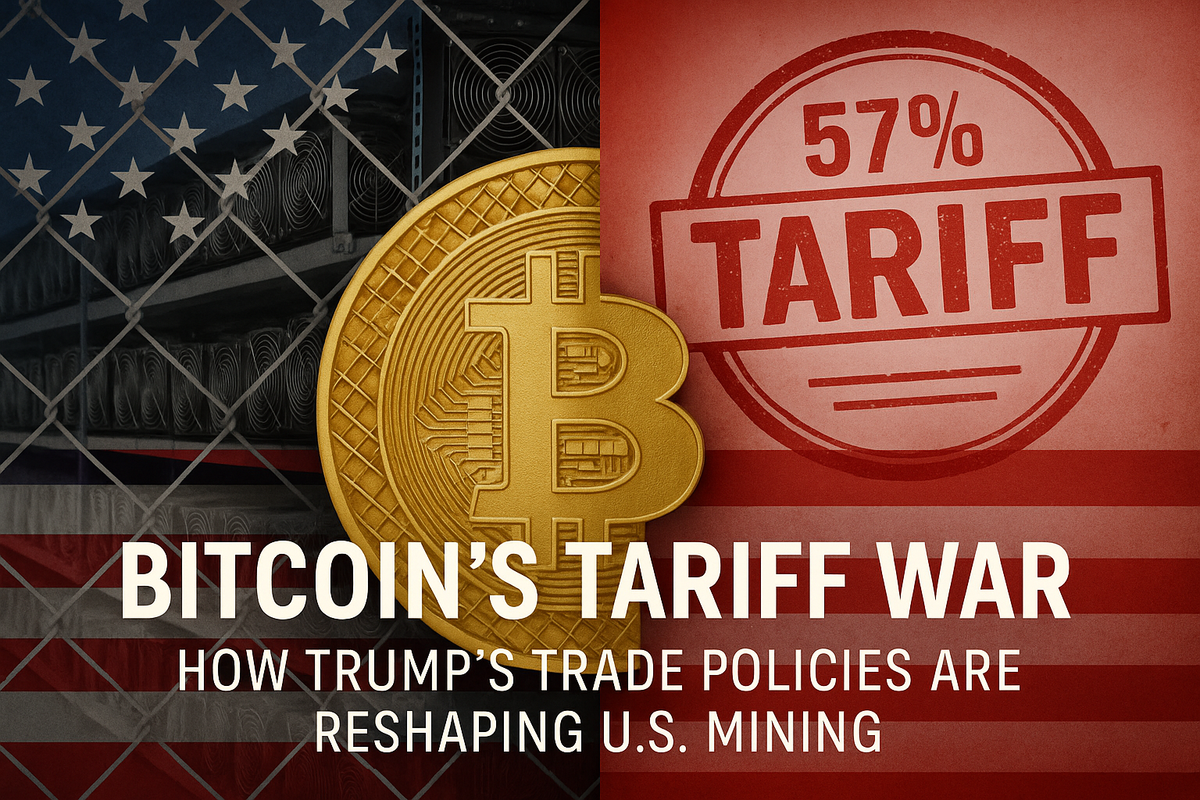Bitcoin’s Tariff War: How Trump’s Trade Policies Are Reshaping U.S. Mining
Trump’s tariffs on Bitcoin miners mark a turning point in the industry. They raise costs, disrupt supply chains, and put pressure on operators already walking a fine line of profitability. onshore production, distressed asset sales, and energy-driven partnerships. -Rafael Benavente

Trump’s Bitcoin Tariffs: How New Trade Policies Reshape Mining Economics in the U.S.
Introduction
In August 2025, the White House rolled out a sweeping set of tariffs that dramatically altered the playing field for Bitcoin miners operating in the United States. Once pitched as a nation that would become a “Bitcoin mining powerhouse,” the U.S. is now at risk of losing its competitive edge due to surging costs on imported hardware. With tariffs as high as 57.6% on rigs from China and 21.6% from Southeast Asia, miners are scrambling to adjust business models, reconfigure supply chains, and reconsider whether U.S. soil is still fertile ground for large-scale mining.
This blog explores the policy background, industry reactions, financial implications, and long-term strategic shifts unfolding in real time. It’s a case study in how geopolitics and economics intersect in the fast-moving world of digital assets.
The Tariff Shock: What Changed
For years, U.S. miners depended heavily on hardware imports from Asia, where firms like Bitmain, MicroBT, and Canaan dominate production of ASIC (application-specific integrated circuit) machines. These rigs are the lifeblood of Bitcoin mining — without them, there is no hashrate, no network security, and no revenue.
Trump’s August 2025 tariff package targeted multiple categories of electronics, including Bitcoin mining hardware. The specifics:
- From China: Total tariff burden now sits at 57.6%, though initial drafts suggested it could rise to 145%.
- From Indonesia, Malaysia, Thailand: Combined tariffs of 21.6%.
- From elsewhere: Mixed treatment, with limited exemptions.
For miners, this is a direct cost increase on capex. A rig that cost $3,000 FOB Shenzhen now lands in the U.S. closer to $4,600–$4,800 after duties, shipping, and insurance.
Industry’s Immediate Response
The industry reacted with a mix of urgency and pragmatism.
- Inventory Rush: In April 2025, before the tariffs hit, firms like Luxor reportedly chartered entire Boeing 777s to fly in rigs, paying shipping rates 10x higher than usual. It was a scramble to front-load inventory.
- Used Market Boom: Tariffs created a premium on rigs already in the U.S. Domestic resale prices climbed, giving secondhand miners a short-term windfall.
- Canadian Alternative: Some firms looked north, leveraging Canada’s free-trade routes and cheaper hydro power. Importing through Canadian subsidiaries became a workaround.
This scramble highlights how vulnerable the mining sector is to policy shocks, given its razor-thin margins and reliance on predictable input costs.
Financial Strain on Miners
Mining is already a game of tight economics — electricity costs, hosting fees, and machine depreciation squeeze operators even in favorable conditions. With tariffs, the squeeze is worse.
- Operating Margin Compression: Higher upfront capex means longer ROI cycles. Machines that once paid themselves off in 18–24 months now stretch to 30+ months.
- Balance Sheet Pressures: Firms like Greenidge have already been forced into asset sales, offloading a Mississippi facility for $3.9 million. Others may follow.
- Investor Sentiment: Publicly traded miners saw stock price volatility increase in August 2025, as analysts revised earnings forecasts downward.
For distressed-asset investors, this environment presents buying opportunities. Miners with weak balance sheets and tariff-inflated costs could become acquisition targets at a discount.
Strategic Shift: Onshore Production
Tariffs are forcing a long-term industry pivot: local production of mining rigs.
- Bitmain, MicroBT, and Canaan are establishing production and assembly lines in the U.S. to bypass tariffs.
- This is reminiscent of the way automakers like Toyota and BMW built U.S. factories in the 1980s to dodge import barriers.
- While local production will take time to scale, it represents a structural realignment in the global Bitcoin supply chain.
However, onshoring ASIC production is capital intensive and technologically challenging. Chip fabrication still depends on Taiwan’s TSMC and South Korea’s Samsung, meaning true independence is unlikely in the near term.
Policy Contradictions
There’s a paradox at play.
- On one hand, the administration has touted the U.S. as the world’s future Bitcoin mining leader.
- On the other, tariffs directly undermine cost competitiveness, pushing miners abroad.
Some industry advocates argue for exemptions under tariff schedules — similar to how computer imports are treated. Whether Washington listens will depend on lobbying power and political optics.
Supply Chain Diversification
Beyond onshoring, miners are exploring other supply-chain strategies:
- Latin America: Mexico and Paraguay are emerging as attractive hosts, offering cheaper energy and less regulatory friction.
- Europe & the Middle East: Kazakhstan remains active, while Middle Eastern states like Oman are positioning as mining hubs with cheap energy.
- Used U.S. Inventory: A parallel “gray market” is emerging, where pre-tariff rigs trade at premiums.
These dynamics mirror broader globalization trends: wherever policy closes a door, capital finds another route.
Investor’s Lens: Opportunities and Risks
Distressed Debt & Equity Plays
With miners under strain, distressed opportunities are rising. Asset sales, discounted debt, and restructuring negotiations will accelerate. Investors who specialize in distressed credit and turnaround equity may find value plays.
Energy Partnerships
Mining’s biggest input is electricity. Tariffs make energy partnerships even more important:
- Locking in low-cost hydro, wind, or nuclear power can offset hardware premiums.
- Firms with PPA (power purchase agreements) below $0.05/kWh will outperform peers stuck paying market rates.
Technology Hedge
Investors may also explore exposure to next-generation chips and immersion cooling technology, which help extend machine lifespan and reduce breakeven costs.
Case Study: Greenidge’s Asset Sale
The case of Greenidge encapsulates the sector’s struggles. Once an ambitious U.S. miner, Greenidge announced the sale of its Mississippi facility for $3.9 million to raise liquidity. The decision followed months of financial pressure — tariffs only accelerated the move.
This is a warning sign for mid-tier operators. Unless balance sheets are fortified with cheap energy deals, strong treasury management, and alternative revenue streams (like AI compute leasing), more sales and bankruptcies could follow.
Global Competitiveness: Can the U.S. Still Lead?
The U.S. still has advantages:
- Deep capital markets.
- Access to some of the world’s cheapest renewable energy.
- Legal infrastructure that supports large-scale projects.
But tariffs are chipping away at these strengths. If production moves offshore, the U.S. may find itself lagging behind Canada, Latin America, or the Middle East.
Ultimately, global Bitcoin hashrate will continue rising — the question is whether American miners will retain a dominant share or cede ground to competitors abroad.
Table: Key Impacts of Trump’s Bitcoin Mining Tariffs
| Factor | Before Tariffs | After Tariffs | Implications |
|---|---|---|---|
| ASIC Rig Price (avg) | $3,000–$3,200 | $4,600–$4,800 | Longer ROI, higher capex |
| Import Routes | Direct from China/SE Asia | Diversifying via Canada, local assembly | Supply chain shifts |
| Used Rig Market | Low demand, depreciating quickly | Domestic resale premiums | Short-term gains for resellers |
| Miner Margins | 20–30% (varies by energy cost) | 5–15% in many cases | Squeezed profitability |
| Industry Strategy | Import-driven | Onshore production + energy partnerships | Long-term structural change |
Long-Term Outlook
The mining sector is resilient. Historically, miners have endured regulatory crackdowns, price volatility, and capital droughts. Tariffs are just another hurdle. The longer-term picture depends on three variables:
- Policy Adjustments: Will exemptions or revisions ease the tariff burden?
- Onshore Success: Can U.S.-based production scale efficiently?
- Market Cycles: If Bitcoin rallies past $150,000 in the next bull cycle, higher hardware costs may matter less.
For now, however, tariffs are an undeniable headwind — one that reshapes both the industrial map and the investment thesis for Bitcoin mining in America.
Conclusion
Trump’s tariffs on Bitcoin miners mark a turning point in the industry. They raise costs, disrupt supply chains, and put pressure on operators already walking a fine line of profitability. Yet they also catalyze structural shifts: onshore production, distressed asset sales, and energy-driven partnerships.
For policymakers, this is a cautionary tale about the unintended consequences of trade barriers. For investors, it’s a reminder that disruption often creates opportunity. And for miners, it’s a stark new reality: adapt quickly, or risk being mined out of the market.
by Rafael Benavente
